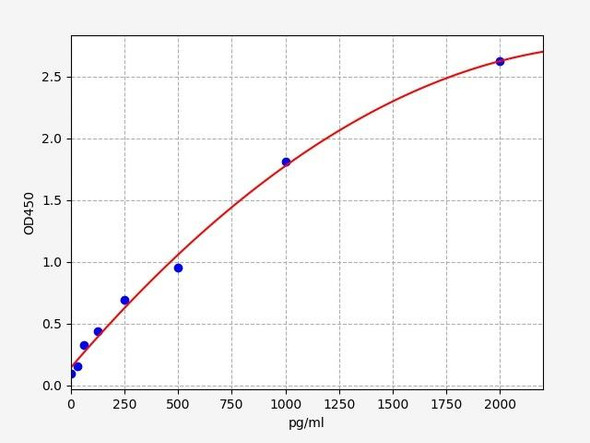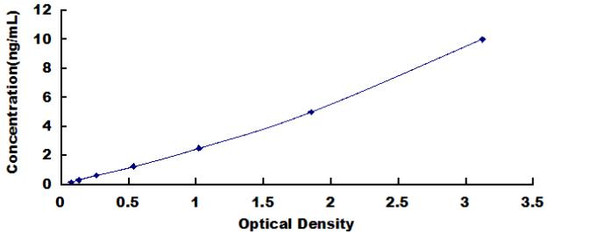Human BLNK (B-Cell Linker Protein) ELISA Kit (HUES01743)
- SKU:
- HUES01743
- Product Type:
- ELISA Kit
- Size:
- 96 Assays
- Uniprot:
- Q8WV28
- Sensitivity:
- 0.09ng/mL
- Range:
- 0.16-10ng/mL
- ELISA Type:
- Sandwich
- Synonyms:
- AGM4, BASH, BLNK-S, LY57, SLP-65, SLP65, BCA
- Reactivity:
- Human
- Sample Type:
- Serum, plasma and other biological fluids
- Research Area:
- Immunology
Description
Human BLNK (B-Cell Linker Protein) ELISA Kit
The Human BLNK (B Cell Linker Protein) ELISA Kit is a valuable tool for detecting BLNK levels in human serum, plasma, and cell culture supernatants. This kit offers highly sensitive and specific detection capabilities, ensuring accurate and consistent results for a variety of research purposes.BLNK, also known as SLP-65, plays a critical role in B cell signaling and activation, making it a key player in the immune response and antibody production.
Aberrant BLNK levels have been linked to autoimmune diseases, B cell lymphomas, and other immune disorders, highlighting its importance as a biomarker in understanding and treating these conditions.Overall, the Human BLNK ELISA Kit provides researchers with a precise and reliable method for quantifying BLNK levels, opening up new possibilities for studying B cell function and immune system regulation.
| Assay type: | Sandwich |
| Format: | 96T |
| Assay time: | 4.5h |
| Reactivity: | Human |
| Detection Method: | Colormetric |
| Detection Range: | 0.16-10 ng/mL |
| Sensitivity: | 0.10 ng/mL |
| Sample Volume Required Per Well: | 100µL |
| Sample Type: | Serum, plasma and other biological fluids |
| Specificity: | This kit recognizes Human BLNK in samples. No significant cross-reactivity or interference between Human BLNK and analogues was observed. |
This ELISA kit uses Sandwich-ELISA as the method. The micro ELISA plate provided in this kit has been pre-coated with an antibody specific to Human BLNK. Standards or samples are added to the appropriate micro ELISA plate wells and combined with the specific antibody. Then a biotinylated detection antibody specific for Human BLNK and Avidin-Horseradish Peroxidase (HRP) conjugate are added to each micro plate well successively and incubated. Free components are washed away. The substrate solution is added to each well. Only those wells that contain Human BLNK, biotinylated detection antibody and Avidin-HRP conjugate will appear blue in color. The enzyme-substrate reaction is terminated by adding Stop Solution and the color turns yellow. The optical density (OD) is measured spectrophotometrically at a wavelength of 450 nm ± 2 nm. The OD value is proportional to the concentration of Human BLNK. The concentration of Human BLNK in samples can be calculated by comparing the OD of the samples to the standard curve.
| UniProt Protein Function: | BLNK: an adaptor protein that bridges the B-cell receptor-associated kinases (BCR) with a multitude of signaling pathways, regulating biologic outcomes of B-cell function and development. Plays an important role in BCR-mediated PLCG1 activation and Ca(2 ) mobilization. Does not seem to be not required for pre-BCR-mediated activation of MAP kinase and phosphatidyl-inositol 3 (PI3) kinase signaling. Plays a critical role in orchestrating the pro-B cell to pre-B cell transition. Following BCR activation, phosphorylated on tyrosine residues by SYK and LYN. When phosphorylated, serves as a scaffold to assemble downstream targets of antigen activation, including PLCG1, VAV1, GRB2 and NCK1. Its phosphorylation is required for both Ca(2 ) and MAPK signaling pathways. Defects in BLNK are the cause of hypoglobulinemia and absent B-cells. It has tumor supressor activity that is lost in many cases of childhood pre-B acute lymphoblastic leukemia (ALL). Two alternatively spliced isoforms have been described; these are differentially involved in activation and apoptosis of B lymphocytes. |
| UniProt Protein Details: | Protein type:Adaptor/scaffold Chromosomal Location of Human Ortholog: 10q23. 2-q23. 33 Cellular Component: cytoplasm; cytosol; plasma membrane Molecular Function:protein binding; SH3/SH2 adaptor activity; transmembrane receptor protein tyrosine kinase adaptor protein activity Biological Process: humoral immune response; inflammatory response Disease: Agammaglobulinemia 4, Autosomal Recessive |
| NCBI Summary: | This gene encodes a cytoplasmic linker or adaptor protein that plays a critical role in B cell development. This protein bridges B cell receptor-associated kinase activation with downstream signaling pathways, thereby affecting various biological functions. The phosphorylation of five tyrosine residues is necessary for this protein to nucleate distinct signaling effectors following B cell receptor activation. Mutations in this gene cause hypoglobulinemia and absent B cells, a disease in which the pro- to pre-B-cell transition is developmentally blocked. Deficiency in this protein has also been shown in some cases of pre-B acute lymphoblastic leukemia. Alternatively spliced transcript variants have been found for this gene. [provided by RefSeq, May 2012] |
| UniProt Code: | Q8WV28 |
| NCBI GenInfo Identifier: | 82592659 |
| NCBI Gene ID: | 29760 |
| NCBI Accession: | Q8WV28. 2 |
| UniProt Secondary Accession: | Q8WV28,O75498, O75499, Q2MD49, |
| UniProt Related Accession: | Q8WV28 |
| Molecular Weight: | 44,451 Da |
| NCBI Full Name: | B-cell linker protein |
| NCBI Synonym Full Names: | B-cell linker |
| NCBI Official Symbol: | BLNK |
| NCBI Official Synonym Symbols: | bca; AGM4; BASH; LY57; SLP65; BLNK-S; SLP-65 |
| NCBI Protein Information: | B-cell linker protein |
| UniProt Protein Name: | B-cell linker protein |
| UniProt Synonym Protein Names: | B-cell adapter containing a SH2 domain protein; B-cell adapter containing a Src homology 2 domain protein; Cytoplasmic adapter protein; Src homology 2 domain-containing leukocyte protein of 65 kDa; SLP-65 |
| Protein Family: | B-cell linker protein |
| UniProt Gene Name: | BLNK |
| UniProt Entry Name: | BLNK_HUMAN |
As the OD values of the standard curve may vary according to the conditions of the actual assay performance (e. g. operator, pipetting technique, washing technique or temperature effects), the operator should establish a standard curve for each test. Typical standard curve and data is provided below for reference only.
| Concentration (ng/mL) | O.D | Average | Corrected |
| 10 | 2.356 2.4 | 2.378 | 2.315 |
| 5 | 1.529 1.543 | 1.536 | 1.473 |
| 2.5 | 0.87 0.848 | 0.859 | 0.796 |
| 1.25 | 0.442 0.448 | 0.445 | 0.382 |
| 0.63 | 0.248 0.236 | 0.242 | 0.179 |
| 0.32 | 0.162 0.156 | 0.159 | 0.096 |
| 0.16 | 0.104 0.122 | 0.113 | 0.05 |
| 0 | 0.058 0.068 | 0.063 | -- |
Precision
Intra-assay Precision (Precision within an assay): 3 samples with low, mid range and high level Human BLNK were tested 20 times on one plate, respectively.
Inter-assay Precision (Precision between assays): 3 samples with low, mid range and high level Human BLNK were tested on 3 different plates, 20 replicates in each plate.
| Intra-assay Precision | Inter-assay Precision | |||||
| Sample | 1 | 2 | 3 | 1 | 2 | 3 |
| n | 20 | 20 | 20 | 20 | 20 | 20 |
| Mean (ng/mL) | 0.46 | 0.96 | 4.93 | 0.47 | 0.98 | 4.76 |
| Standard deviation | 0.03 | 0.04 | 0.25 | 0.02 | 0.05 | 0.18 |
| C V (%) | 6.52 | 4.17 | 5.07 | 4.26 | 5.10 | 3.78 |
Recovery
The recovery of Human BLNK spiked at three different levels in samples throughout the range of the assay was evaluated in various matrices.
| Sample Type | Range (%) | Average Recovery (%) |
| Serum (n=5) | 87-101 | 92 |
| EDTA plasma (n=5) | 91-105 | 97 |
| Cell culture media (n=5) | 86-100 | 92 |
Linearity
Samples were spiked with high concentrations of Human BLNK and diluted with Reference Standard & Sample Diluent to produce samples with values within the range of the assay.
| Serum (n=5) | EDTA plasma (n=5) | Cell culture media (n=5) | ||
| 1:2 | Range (%) | 99-115 | 97-109 | 97-113 |
| Average (%) | 105 | 102 | 105 | |
| 1:4 | Range (%) | 89-101 | 83-94 | 83-97 |
| Average (%) | 94 | 89 | 89 | |
| 1:8 | Range (%) | 86-101 | 79-92 | 85-96 |
| Average (%) | 92 | 85 | 90 | |
| 1:16 | Range (%) | 90-104 | 81-95 | 89-99 |
| Average (%) | 96 | 87 | 94 |
An unopened kit can be stored at 4°C for 1 month. If the kit is not used within 1 month, store the items separately according to the following conditions once the kit is received.
| Item | Specifications | Storage |
| Micro ELISA Plate(Dismountable) | 8 wells ×12 strips | -20°C, 6 months |
| Reference Standard | 2 vials | |
| Concentrated Biotinylated Detection Ab (100×) | 1 vial, 120 µL | |
| Concentrated HRP Conjugate (100×) | 1 vial, 120 µL | -20°C(shading light), 6 months |
| Reference Standard & Sample Diluent | 1 vial, 20 mL | 4°C, 6 months |
| Biotinylated Detection Ab Diluent | 1 vial, 14 mL | |
| HRP Conjugate Diluent | 1 vial, 14 mL | |
| Concentrated Wash Buffer (25×) | 1 vial, 30 mL | |
| Substrate Reagent | 1 vial, 10 mL | 4°C(shading light) |
| Stop Solution | 1 vial, 10 mL | 4°C |
| Plate Sealer | 5 pieces | |
| Product Description | 1 copy | |
| Certificate of Analysis | 1 copy |
- Set standard, test sample and control (zero) wells on the pre-coated plate and record theirpositions. It is recommended to measure each standard and sample in duplicate. Note: addall solutions to the bottom of the plate wells while avoiding contact with the well walls. Ensuresolutions do not foam when adding to the wells.
- Aliquot 100 µL of standard solutions into the standard wells.
- Add 100 µL of Sample / Standard dilution buffer into the control (zero) well.
- Add 100 µL of properly diluted sample (serum, plasma, tissue homogenates and otherbiological fluids) into test sample wells.
- Cover the plate with the sealer provided in the kit and incubate for 90 min at 37 °C.
- Aspirate the liquid from each well, do not wash. Immediately add 100 µL of BiotinylatedDetection Ab working solution to each well. Cover the plate with a plate seal and gently mix. Incubate for 1 hour at 37 °C.
- Aspirate or decant the solution from the plate and add 350 µL of wash buffer to each welland incubate for 1-2 minutes at room temperature. Aspirate the solution from each well andclap the plate on absorbent filter paper to dry. Repeat this process 3 times. Note: a microplatewasher can be used in this step and other wash steps.
- Add 100 µL of HRP Conjugate working solution to each well. Cover with a plate seal andincubate for 30 min at 37 °C.
- Aspirate or decant the solution from each well. Repeat the wash process for five times asconducted in step 7.
- Add 90 µL of Substrate Reagent to each well. Cover with a new plate seal and incubate forapproximately 15 min at 37 °C. Protect the plate from light. Note: the reaction time can beshortened or extended according to the actual color change, but not by more than 30min.
- Add 50 µL of Stop Solution to each well. Note: Adding the stop solution should be done inthe same order as the substrate solution.
- Determine the optical density (OD value) of each well immediately with a microplate readerset at 450 nm.










